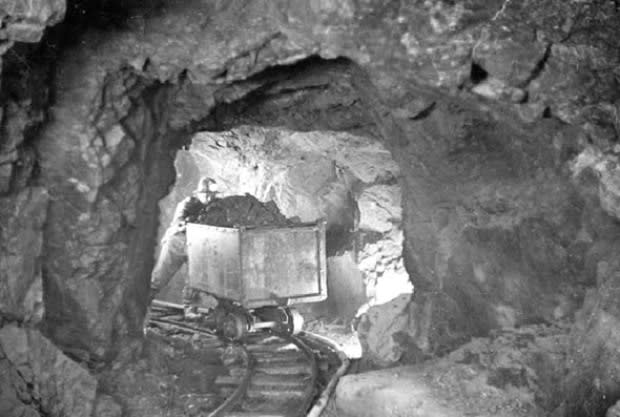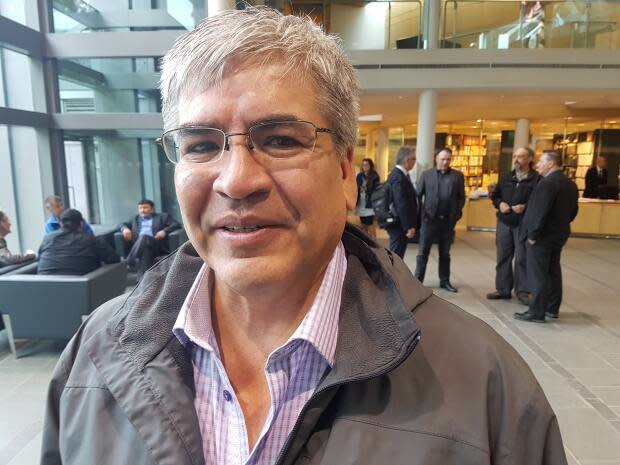Spectre of atomic bomb still looms over N.W.T. community 75 years after Hiroshima
Seventy-five years after two nuclear bombs were dropped in Japan — killing hundreds of thousands of people in the cities of Hiroshima and Nagasaki — one small community in the Northwest Territories is still haunted by its connection to the blasts.
Across Great Bear Lake from the 533-person hamlet of Délı̨nę sits the historic mining site of Port Radium.
Workers originally mined radium for medical use. But at the height of the Second World War, the Canadian government quietly called for uranium production as part of the country's involvement in the Manhattan Project.
That uranium was sent south to help the United States with the race to build a nuclear bomb.
Eventually, two Allied bombs were dropped on Hiroshima and Nagasaki. Some estimates say 200,000 people died.
Wondering about the risks
On the other side of the world near Great Bear Lake, workers would eventually wonder about the risks they took delivering sacks of ore on their backs as they sent it south — without being told what they were about to be complicit in.
Danny Gaudet chaired a joint committee between Délı̨nę and the federal government on uranium mining in the area, which published its final report in 2005. He had hoped the report would lead to an apology to community members from the government for both their physical risks and moral injuries, but that hasn't happened.
"One of the biggest things that the elders in the group always asked for is: 'Just simply apologize to us, acknowledge you did something wrong," said Gaudet. "That starts the healing journey."
Days after the blasts, the Canadian government announced the country's role in the explosions, citing the Great Bear Lake mine's uranium as a key ingredient for the project, said Geoffrey Bird, a professor at Royal Roads University in Victoria who studies tourism and the history of remembrance.
An English-language sign connecting Port Radium to the atomic bomb was photographed in Délı̨nę in December 1945.

Bird said that means people in Délı̨nę would only have learned about their involvement in Hiroshima after it was too late. Even the federal announcement may not have been processed by everyone in Délı̨nę, a community that included unilingual Indigenous language speakers living traditional lifestyles, and the knowledge may not have been formally passed on.
"There's a little bit of a fog in those elements," said Bird.
Gaudet said they are a traditional people and the work at the mine was a "top military operation."
"Nobody knew what it was for — even transporting it out of the area was all secretive."
While the Canadian government hasn't apologized to Délı̨nę, the community has apologized to Japan.

Cindy Gilday was part of that apology.
Today, the environmentalist and Indigenous rights activist is still concerned about how mining may have affected the health of Délı̨nę and other sites along the Great Bear River and the route where ore was transported south.
"I'm hoping the Government of Canada will have the courage to revisit this question with the Dene Nation and at least provide a lot more detail," Gilday said.
'I can't have that trust with them if they don't apologize'
Locals in Délı̨nę say many ore workers and their family members developed cancer later in life. Many in that generation have since died.
In the book If Only We Had Known, which tells the story of Port Radium from the eyes of the Sahtúot'ine, elders remember workers' clothing covered with dust, windy days when ore was caught up in the air and children playing games in mine tailings.
They're prepared to forgive. - Morris Neyelle
The joint 2005 report between Délı̨nę and the federal government, written by the committee Gaudet chaired, found that the risks of radiation-related cancers for people who moved ore at the mine are not much higher than normal levels, and are even more negligible for their families.
Ottawa also says the site was cleaned up according to standards laid out in the 2005 report, and in 2016, a site inspection showed that "remediation methods are working as planned."
But the 2005 report also said there is no evidence ore carriers in the Sahtu, or their non-Dene colleagues underground in the mines, were warned their work could be dangerous.
Morris Neyelle, who worked at the former uranium mine site in 1978 when it was later producing silver, said it's hard to believe Canada's scientific data about the area if that information isn't paired with empathy.
"I can't have that trust with them if they don't apologize," he said. "I really don't understand because the community of Délı̨nę, they are a peaceful people. They're prepared to forgive."
Government says it's working with community
Gilday and Gaudet both say they want more support for Indigenous people to take the lead on studying the site so that people can have full confidence in the findings.
Gilday said she believes it's also on the next generation of Indigenous northerners to make Canada take this issue seriously.
"It's time for the young people from the Dene Nation to step up to the plate and carry on a story that began on Great Bear Lake and down the river," she said.
CBC asked the Prime Minister's Office if there were any plans to apologize to the community of Délı̨nę, and was referred to Crown-Indigenous Relations and Northern Affairs Canada.
In an email, the department said that the government has recognized historic uranium mining around Great Bear Lake is an important issue to Délı̨nę, and that it is working with the community on further resolution.
Neyelle said until that happens, he'll keep speaking up.
"I had always promised myself, if it has to deal with the land I live on, I would do whatever it takes to stand my ground," he said. "With the land, I don't need anything. I have everything. But if I lose it, then I have nothing to fight for."

